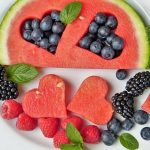Beautiful skin does not come from a face cream or treatment, it comes from within. The turnover of older skin cells is constant, so a regular supply of nutrients is necessary to support this. If you want your skin to look its best, you need to make sure you’re eating the right foods. Eating a balanced diet will help keep your skin soft, supple, and blemish-free.
1. Eat a minimum of five portions of fruit and vegetables every day.
Fruits and vegetables are good for your skin because they contain antioxidants, which help protect your skin cells from damage caused by free radicals. Smoking, pollution, and exposure to sunlight can all contribute to the formation of free radicals.
You should eat a variety of colorful fruits and vegetables every day, and try to have at least five servings.
Both beta-carotene and lutein are important for normal skin cell development and healthy skin tone. Beta-carotene is found in orange fruit and vegetables such as carrots, sweet potatoes and pumpkins, while lutein is found in kale, papaya and spinach.
2. Get your vitamin C.
We need vitamin C to support the immune system, promote healthy skin and help blemishes heal. The best sources of Vitamin C are blackcurrants, blueberries, broccoli, guava, kiwi fruits, oranges, papaya, strawberries and sweet potatoes.
Vitamin C is also important for producing collagen, which helps keep skin looking plump and supported. Collagen also strengthens the blood vessels that supply nutrients to the skin.
3. Eat enough vitamin E.
Vitamin E is important for protecting the skin from damage caused by exposure to the sun. Some foods that are high in vitamin E are almonds, avocados, hazelnuts, pine nuts, sunflower oil, and pumpkin seed oil.
4. Stock up on selenium.
Selenium is an antioxidant that works with vitamins C and E. Many studies have found that selenium can help protect against skin cancer, sun damage, and age spots.
Eating Brazil nuts is one way to increase your intake. Just 2-3 nuts will provide your recommended daily amount. Try adding Brazil nuts to your next snack or salad for a boost of vitamin E.
Some other good sources of zinc include fish, shellfish, eggs, wheatgerm, tomatoes, and broccoli.
5. Eat plenty of zinc.
Zinc helps to keep skin supple by supporting the normal functioning of oil-producing glands in the skin. Vitamin C is also responsible for helping the skin heal and repairing any damage that has been done. Foods that are rich in zinc include fish, lean red meat, wholegrains, poultry, nuts, seeds and shellfish.
6. Include healthy fats, especially omega-3.
Certain fats act as a natural moisturizer for your skin, keeping it supple from the inside and improving elasticity. Some examples of these fats are found in fish, olive oil, and avocados.
The fats that are good for you include monounsaturated and polyunsaturated fats, which are found in avocados, oily fish, nuts, and seeds. These fats are smartly packaged with a healthy amount of vitamin E.
Make sure to get plenty of omega-3 fatty acids in your diet. These are found in food sources like fatty fish, eggs, and some plants. The fatty acids in this food are beneficial for reducing inflammation and they may also help improve skin conditions such as eczema and psoriasis. They also form the building blocks of healthy skin.
You can find omega-3 in oily fish, such as salmon, trout and sardines as well as plant sources including flaxseed, chia seeds, walnuts and rapeseed oil.
7. Eat more phyto-estrogens
Phyto-estrogens are natural compounds found in plants. The structure of these chemicals is similar to the female sex hormone estrogen. It is thought that they help to keep our natural hormones in balance.
It is important to have a healthy level of estrogen because it helps to support the skin’s structure and decrease the amount of skin damage.
The plant estrogens found in soy (isoflavones) such as tofu and tempeh, as well as the fiber of wholegrains, fruit, vegetables and flaxseed (lignans), offer different benefits.
It may be helpful to eat foods that are rich in phytoestrogens during key life stages, such as midlife. These include soya, wholegrains, fruits, and vegetables.
8. Drink six to eight glasses of water a day.
Skin needs moisture to stay flexible. If you are even slightly dehydrated, your skin may look dry, tired, and slightly gray. It is recommended by experts that we drink six to eight glasses of water a day. All types of fluids contribute to your daily recommended intake, but water is the most beneficial.
If you have a job that requires you to sit at a desk, it can be easy to forget to drink water throughout the day. Placing a large bottle of water on your desk can help serve as a reminder to drink water regularly. Herbal, caffeine-free teas are good, too.
Some fruit and vegetables, like watermelon, courgette, and cucumber, contain fluids that will help you hydrate your body and skin.
9. Go for low-GI carbs.
The glycaemic index is a system that ranks foods based on how slowly or quickly they are broken down into glucose. You should try to eat foods that are low on the glycemic index and that release slowly. These include beans, pulses, and porridge.
These carbs provide you with a steady supply of energy and leave you feeling satisfied and less likely to snack.
You should avoid high-GI carbohydrates such as biscuits and sugary drinks. These types of carbohydrates can lead to the production of insulin, which may damage collagen and accelerate wrinkles.
10. Don’t crash diet.
If you’re constantly losing and gaining weight, your skin will eventually start to sag, wrinkle, and develop stretch marks. Crash diets don’t usually have all the essential vitamins and minerals that you need. This type of dieting will have an effect on your skin over long periods of time.
Other lifestyle factors that impact the look and appearance of skin are smoking and consuming alcohol excessively.
11. Eat fatty fish.
Fish that are high in fat, such as salmon, mackerel, and herring, are great for your skin. They are full of omega-3 fatty acids, which are great for your skin.
Omega-3 fatty acids are necessary for keeping skin thick, supple, and moisturized. A deficiency in omega-3 fatty acids can lead to dry skin.
Fish oil can help to reduce acne by reducing inflammation. They can limit your skin’s exposure to the sun’s harmful ultraviolet rays.
Several studies suggest that fish oil supplements may improve inflammatory and autoimmune skin conditions such as psoriasis and lupus. Fish rich in fat also contain high levels of vitamin E, an essential nutrient for maintaining healthy skin.
Vitamin E is important for protecting your skin against damage from free radicals and inflammation. Seafood is a good source of protein, which is important for strong and healthy skin.
Lastly, fish provides zinc — a mineral vital for regulating the following:
- inflammation
- overall skin health
- the production of new skin cells
Zinc deficiency can cause skin inflammation, lesions, and delays in wound healing.
Fish that are high in fat, like salmon, contain omega-3 fatty acids. These acids can reduce inflammation and help your skin to retain moisture. Another plus of peanuts is that they contain high levels of protein, vitamin E, and zinc.
Avocados are high in healthy fats. Fats are beneficial for many functions in your body, including skin health. You need to consume enough of these fats to keep your skin flexible and moisturized.
Over 700 women were studied to see the effects of a high intake of healthy fats, such as those found in avocados. The study found that these fats resulted in supple, springy skin.
So far, there is some evidence to suggest that avocados may help protect your skin from the harmful effects of the sun. Ultraviolet radiation can cause skin damage that manifests as wrinkles and other visible signs of aging.
Avocados contain a good amount of vitamin E, which is beneficial as an antioxidant. This vitamin helps to protect your skin from oxidative damage. Many Americans don’t get the recommended amount of vitamin E through their diet.
Vitamin E is more effective when combined with Vitamin C. Vitamin C is also essential for healthy skin. Your skin needs vitamin C to create collagen. Collagen is the main structural protein that keeps your skin strong and healthy.
Vitamin C deficiency is now rare, but common symptoms back then included dry, rough, and scaly skin that tended to bruise easily. Vitamin C inhibits the oxidation of other molecules in the body, which can help protect your skin from damage caused by exposure to the sun and other environmental factors, leading to fewer signs of aging.
If you eat half an avocado, you will be getting 14% of your daily value for vitamin E and 11% of your daily value for vitamin C.
The fats in avocados are good for you, and they also contain vitamins E and C, which are both important for healthy skin. They also contain compounds that may protect your skin from sun damage.
13. Walnuts
The fatty acids in walnuts can help to improve skin health. Essential fatty acids are fats that your body cannot make itself, and they’re a good source of those.
A diet consisting of too many omega-6 fats may unintentionally promote inflammation and disorders of the skin, like psoriasis. Omega-3 fats have the opposite effect of omega-6 fats when it comes to inflammation in the body, including the skin.
There is an imbalance of omega-6 to omega-3 fatty acids in the Western diet. Walnuts may help reduce inflammation because they contain a good ratio of omega-6 to omega-3 fatty acids.
In addition to containing the omega-3 fatty acids that are good for your skin, walnuts also contain other nutrients that are necessary for your skin to function properly and stay healthy. This means that one ounce of walnuts contains 8% of the recommended daily value for zinc.
Zinc is necessary for your skin’s barrier function. Zinc is important for many bodily functions, including wound healing and fighting bacteria and inflammation. The antioxidants in walnuts, vitamin E and selenium, work together to protect cells from damage. Walnuts contain 4–5 grams of protein per ounce (28 grams), which helps the body to repair cells and to create new ones.
Walnuts are rich in nutrients that are good for your skin, such as essential fats, zinc, vitamin E, selenium, and protein.
14. Sunflower Seeds
Nuts and seeds are good sources of nutrients that can improve your skin. Sunflower seeds are an excellent example.
One ounce of sunflower seeds provides 49% of the recommended daily value for vitamin E, 41% of the recommended daily value for selenium, 14% of the recommended daily value for zinc, and 5.5 grams of protein.
Sunflower seeds are packed with nutrients, one of which is vitamin E. This vitamin is important for skin health, as it is an antioxidant.
15. Sweet Potatoes
Beta carotene is a nutrient found in plants. This means it can act as a pro-vitamin A, meaning it can be changed into vitamin A within your body. Vegetables such as carrots, spinach, and sweet potatoes contain beta carotene.
One half cup of baked sweet potato contains beta carotene, which provides more than six times the DV, or daily value, of vitamin A.
Carotenoids, like beta carotene, help keep your skin healthy by blocking UV rays. This antioxidant is consumed and helps protect your skin cells from sun exposure when it is incorporated into your skin. This may help to prevent sunburn, cell death and dry, wrinkled skin.
An interesting side effect of beta carotene is that it can give your skin a warm, orange hue, which makes you look healthier overall.
Sweet potatoes are a good source of beta carotene, which can act as a natural sunblock and may help protect your skin from sun damage.
16. Red or Yellow Bell Peppers
Bell peppers are similar to sweet potatoes in that they are a great source of beta carotene. Beta carotene is converted into vitamin A by the body. One cup (149 grams) of chopped red bell pepper contains the equivalent of more than 150% of the daily recommended value for vitamin A.
A bell pepper contains a large amount of vitamin C, about 211% of the recommended daily value.
According to a large observational study, eating plenty of vitamin C is linked to a reduced risk of wrinkled and dry skin as you age.
Bell peppers are a great source of beta carotene and vitamin C, both of which are important antioxidants for your skin. Vitamin C helps to create collagen, the protein that keeps your skin strong.
17. Broccoli
Zinc, vitamin A, and vitamin C are just a few of the many vitamins and minerals found in broccoli that are important for skin health. This text also contains information about lutein, a carotenoid that has similar effects to beta carotene. Lutein helps to prevent your skin from oxidative damage, which can leave your skin feeling dry and wrinkled.
The florets of broccoli also contain a compound called sulforaphane, which has some impressive potential benefits. Some studies suggest that it has anti-cancer effects, including on some types of skin cancer.
Sulforaphane protects against sun damage. The antioxidant properties of this natural compound work in two ways: they help to neutralize harmful free radicals and they also work to switch on other protective systems in your body.
Sulforaphane has been shown to reduce the number of skin cells killed by UV light by up to 29%, with protection lasting up to 48 hours. Sulforaphane may help to keep collagen levels high in your skin.









